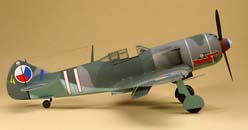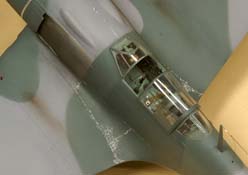Warning: include(/usr/local/psa/home/vhosts/vvs.hobbyvista.com/httpdocs/top.php): failed to open stream: No such file or directory in /home/hobbyvis/public_html/vvs.hobbyvista.com/Modeling/Lavochkin/La-7/Gavia/FullBuild/Roether/index.php on line 14
Warning: include(): Failed opening '/usr/local/psa/home/vhosts/vvs.hobbyvista.com/httpdocs/top.php' for inclusion (include_path='.:/usr/lib/php:/usr/local/lib/php') in /home/hobbyvis/public_html/vvs.hobbyvista.com/Modeling/Lavochkin/La-7/Gavia/FullBuild/Roether/index.php on line 14
Gavia 1/48th
La-7
By Kai Roether |
 |
During the Lavochkin OKB, along with TsAGI (Central institute
for Hydrodynamics and Aerodynamics), conducted research options to improve the
sucesfull fighter La-5FN. The essential method was reduce weight and improve aerodynamic
quality. Many improvments were made, these merging into production of the new
La-7 fighter. The visible
changes included a new position for the oil cooler and supercharger intake. The
result was a higher top speed of 660km/h (La-5FN 620km/h). The front line units
got their first La-7s in the autumn, 1944. There were fluctuations of engine and
airframe quality, and the new rear oil cooler position made the mechanics not
so happy with the new plane, but the pilots loved their new fighter.
After the end of war, the La-7s were quickly retired. The La-7 was a product of
war - cheap and quick in production and not built for a long lifetime. The manufacturer
issued a guarantee for only 2 years. The situation was similar for the other frontline
fighters of Soviet production - Yak-9U, Yak-3.
The 1. Czechoslovak Fighter Regiment was also equiped with
fighters from Lavochkin. Firstly with the La-5FN, which saw active service during
the war. Later (28.04.1945), the La-7 was introduced. The fighters were newly
built and came from the production line in Gorki. Together with some Spitfire
Mk. IXs and S.99s (Czech built Bf-109), the La-7 were the basis of Czech fighter
aviation. Czech fighter aviation was unique for flying these three types. In this
regard the comparative reports from Czech pilots regarding these aircraft are
very interesting (check publication from MBI, see below). Czechoslovakia was the
sole foreign user of the La-7, the last example of which was written off in 1950.
The Model
The project was inspired by the La-7 publication from MBI,
and the La CD of Pilawski/Banyai-Riepl (see references). After the war, the original
stars were overpainted and the Czech roundels were applied.
The model was built using the Gavia kit. The parts are very well detailed and
the outline captures very nicely the original, except the fuselage behind the
cockpit from above - it is too narrow. I decided to leave it as it is.
I began the project by building the wheel wells. Adding wires
gave a more realistic look. The intakes around the wheel well are provided in
the kit and "snapped" in place. The next things to tackle were the flaps. I used
photo etched parts from Eduard and glued and filled with CA glue (superglue).
After this, the wing-halfs were glued together. The
slats were completely scratch-built. First, I removed the original part for the slats.
Then, I filled the gap with a 2-component moulding compound, "Magic Sculp".
Wet fingers were used to shape the compound before it hardened. After drying,
the exact forms where scraped and sanded. The bottom section of thwe wing was
then finished. Now I applied bare metal foil as separation layer, and over that
came another application of "Magic Sculp", again using the wet finger moulding
technique. After sanding down to the level of wing, I removed the part very
carefully and voilá - perfect slats. The slats were mounted on the model
later, after the painting. NB: A specific faeture is noteworthly here - the slats
of La-7 swayed outwards, not linear like the Bf-109.

I wanted to display the motor's louvres in the open position.
The kit has only a closed part in styrene, and so consequently no further details
behind the louvre. I used a motor from the Tamyia Fw-190 kit. In front of this
I mounted an exactly trimmed 1:72 scale MiG-23 radom in the opposite direction.
This allowed for the positioning of the motor deep enough in the fuselage. In
front of this assembly was mounted the correct piece for an open louvre. I picked
it out from the Part (of Poland)
PE-set. Eduard's PE-part for the open louvres is completely wrong.
After painting the motor section (steel) and the cockpit,
and slightly washing these with oil-paints, the fuselage was put together. Thereafter
the fuselage was joined with the wings. Some filling and rescribing (with
CA glue again - because of the rescribing) made the
bird ready for painting.
For painting I used colours from "White Ensign". They have
the most Soviet WWII colours in their portfolio. First I sprayed the lighter gray
(AMT-11). Then I mxed the darker Greengray (AMT-12) with a little bit of AMT-11
and sprayed the darker areas. Afterwards, I used un-mixed AMT-12 for painting
the camouflage pattern. I painted the lower surfaces
in the same manner-- first with ligthened AMT-7 (light
blue), then unmixed AMT-7 for overpainted areas.
After a very decent weathering with pastel chalk and colour chipping with silver
enamel from Revell, the bird could be finally assembled. The wheels were adjusted
(to square), the navigation lights (from CMK) and antenna mounted, the pitot tube
(copper tube) was soldered into place and the last the middle section of canopy
positioned.
Conclusion
A very entertaining build of an outstanding aircraft. I
believe it will not be the last one I make.
References:
Lavockin La-7
Milos Vestsik
MBI
ISBN 80-902238-7-7
Lavochkins Piston Engined Fighters
Yefim Gordon
Red Star Volume 10
Midland Publishing
ISBN 1-85780-151-2
Soviet Air Force Fighter Colours 1941-1945
Erik Pilawski
Classic Publications
ISBN 1-903223-30-X
Radial Enginewd Lavochkins of WW2
Erik Pilawski & Chris Banyai-Riepl
CD

